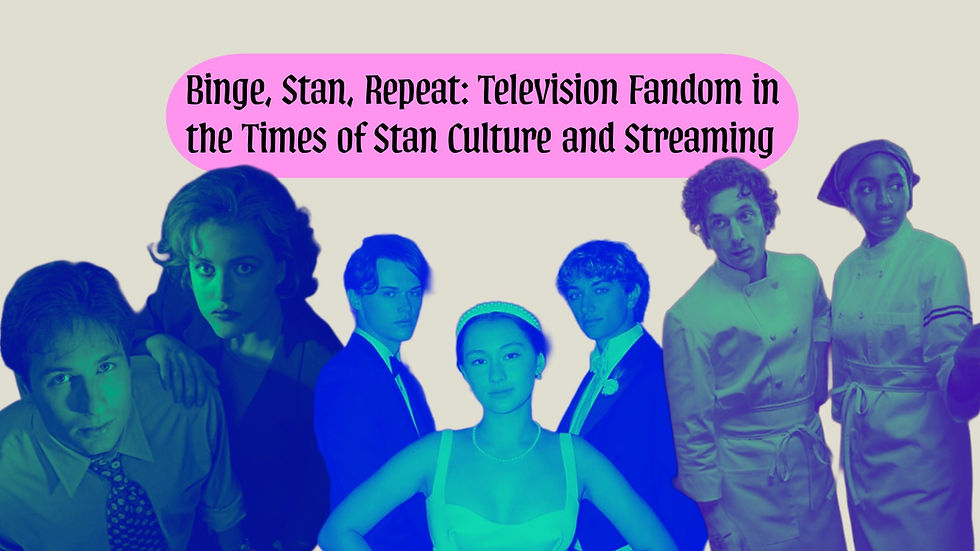Binge, Stan, Repeat: Television Fandom in the Times of Stan Culture and Streaming
- Ana Marks

- Aug 6
- 6 min read
(Slight Warning: Spoilers for The Walking Dead, Stranger Things, and The Bear)

On May 6, 2004, millions of New Yorkers gathered in Times Square to experience the season finale of arguably the most famous sitcom of all time: Friends. After the episode aired, folks presumably chatted about their thoughts with their friends and family on the subway ride home, and furthermore with their coworkers in the break room the next day. Then we all moved on.
Television has a way of integrating itself into ever-changing pop culture. From the introduction of late-night television into the average middle-income home, to watchers across America voting for their favorite couple on Love Island USA every single week. Early instances of fans creating their own spaces for fellow viewers and showrunners alike can be attributed to the early days of Twitter. Immediately after the airing of the episode, it was no longer required to wait to communicate with your friends in real life. The second the credits began to scroll across the silver screen, fans could take their grievances or happiness to the world wide web for all to see. Fandom long existed before the time of social media or even the Internet. Showrunner and filmmaker J.J. Abrams describes the new world of television viewing as "akin to watching theater". The episodic release becomes something of a performance, and reactions would trickle in real-time. He goes on to add, “What was kind of great was that you could use it as one of your tools.” But where does this notion leave us in the current climate of all things streaming, whole-season releases, fandom existing on various platforms, media literacy declining, and so much more?

What came of the fans’ criticism visibility is a change within the writer’s rooms. Suddenly, showrunners had become their own character. They were expected to represent their work in the same fashion that actors had been doing in the past. This is due to the new level of parasocial intimacy on Twitter. Writers, actors, and showrunners alike now had access to initial reactions and had the opportunity to not only engage in online discourse but take from it. Writers now had to dissect the difference between what fans think they wanted for their faves, to what was necessary to produce a decent series with a strong narrative.
Shipping is one of the more popular forms of engagement seen online, dating back to one of television history’s first “cult classics.” ‘The X-Files’ first graced screens in 1993, and Internet fans were quick to harbor a passion for the potential relationship between lead protagonists, Fox Mulder (Dave Duchovny) and Dana Scully (Gillian Anderson). While the show carried sentiments of critiques towards the American government and large institutions and embraced supernatural conspiracy theories, at the center of this show lies an intense coworker-to-lovers (kind of, it’s a little complicated) relationship between Mulder and Scully.
Manifestations of shipping culture begin to trickle into reality, in which the actors face the repercussions of what exactly the fans want to see. Performers now exist as an extension of the series they are dedicating their professional life to. Rumors have long swirled about Anderson and Duchovny, from a famous clip of Anderson winning an award and celebrating by first kissing Duchovny then her boyfriend to the two continuously appearing on red carpets together. Every other summer, an influx of Conrad vs Jeremiah appears on the timeline and creates further discourse, despite the series ‘The Summer I Turned Pretty’ being an adaptation of a completed novel series, with an ending pre-written. While not always harmful, the extent to which shipping culture bleeds into the personal lives of actors emphasizes the issue of potentially too much involvement from fans.
Fans of Netflix’s star show ‘Stranger Things’ have long noticed that Finn Wolfhard and Millie Bobby Brown rarely “interact” anymore, and many users online attribute this public awkwardness to the harassment from Mileven shippers. Fans of the on-screen couple furthermore shipped the actors, looking for public moments between the two to interrogate them about the status of a non-existent romantic relationship. Wolfhard and Brown rarely interact publicly, and users online speculate that the incessant shipping from fans early in the show’s run is a major part of that choice.
Shipping has gone far beyond the streaming culture and fiction television series, where it can now be voted on every day from ‘Love Island USA’. American watchers choose their favorite couple in a similar fashion to how those early viewers of ‘The X-Files’ championed for the couple they desperately wanted to see online. This notion of “America decides” in conjunction with the way that fans can now guide television writers to make choices for their work in real time creates an entirely new question of whether fans of a show should have a say or not. Fans of the hit FX series ‘The Bear’ have long-campaigned for a romantic relationship between Syd (Ayo Edebiri) and Carmy (Jeremy Allen White). As the show continues to air episodes, the fans grow frustrated at the creators’ choice to refrain the two from ever getting together. Instead, the show created a unanimously despised girlfriend from Carmy’s past to deflect from the potential of “sydcarmy.” If a majority of viewership is rooting for one very specific thing, what would be the reason for the writers not to please their viewers?
Shows that remained true to their planned plot point, such as ‘The Walking Dead’ killing fan-favorite character Glenn, lost a major chunk of their loyal fanbase from a decision that was unfavorable. Inversely, the ships and dramatics that surrounded ‘Outer Banks’ upon its newest season led many fans to believe that a crowd favorite character was killed off due to tensions on set. It was speculated that Madison Bailey and Rudy Pankow may have had a small and fleeting romantic relationship at some point throughout the filming of the early seasons, leading fans to ship not only the actors, but their characters as well. Initially, the character of Kie (Bailey) was meant to embark on a relationship with Pope (Jonathan Daviss). However, fans were not shy in their desire to see JJ (Pankow) and Kie end up together.
While the drama is largely speculation from fans and online users, there seems to be a slight correlation in the way that Bailey and Pankow chose to interact with one another publicly, as both were in separate relationships. It was alleged that the two could barely work together despite now having to perform as a romantic couple on-screen.
The term “fan service” historically stems from manga books, in which artists and authors would lean into the riqué nature of the novels for the fans’ pleasure. The problem that fan service has found itself in is that it removes the original integrity of the writing and the natural progression of the narrative. Typical fan service instances revolve around heightened sexuality of characters or exploiting female bodies for the pleasure of a male-dominated audience, such as Princess Leia’s costume in Return of the Jedi, where she is clad in a tiny metal bikini, and enslaved with chains by Jabba the Hut. Other subsets of fan service come in the form of just doing what the audiences want and giving small jolts of excitement that will keep them slightly engaged. This can come in the form of letting two characters with a strong shipper fan base finally be together, or relying on references and nostalgia to keep fans happy, such as the case with Marvel’s latest endeavors.
The change in the format in which television is consumed has also entirely shifted fandom culture and the way that content is discussed. In 2013, Netflix released their first-ever streaming exclusive series ‘House of Cards’ which changed the entertainment industry as we know it today. The days of weekly releases once a year on cable networks dwindled into a void of binging limited series or shows with eight episode seasons. The shift was gradual, of course, but it is impossible to look at the landscape of television without considering such a significant shift. HBO Max has stayed true to their model for the most part, opting to still release episodes on a weekly basis for their original streaming shows. The term “‘Euphoria’ Sundays” created a collective memory in the culture, and the service continues to find success within their weekly releases such as ‘The Last of Us,’ ‘Succession,’ ‘The Pitt,’ and more. Netflix has now fully integrated a “parts” release system, in which they drop a few of the first half of one season at one point, then wait roughly a month or so to drop the other part. This model was highly impactful in the summer of 2022, where ‘Stranger Things’ felt inescapable. It was the show of the summer because it kept its momentum alive with the two different drops.
Oftentimes, discourse around the steady decline of media literacy surrounds how audiences interact with the content and art they are actively consuming. Television writing consists of more telling than showing because the writers have lost faith in their readers’ intellect. The blurred line between actor, creator, and character that social media has created for stans has become a prominent issue for the developing nature of TV.













Comments